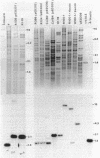Abstract
Conjugative pili are expressed by derepressed plasmids and initiate cell-to-cell contact during bacterial conjugation. They are also the site of attachment for pilus-specific phages (f1, f2, and QB). In this study, the number of pili per cell and their ability to retract in the presence of cyanide was estimated for 13 derepressed plasmids. Selected pilus types were further characterized for reactivity with anti-F and anti-ColB2 pilus antisera as well as two F pilus-specific monoclonal antibodies, one of which is specific for a sequence common to most F-like pilin types (JEL92) and one which is specific for the amino terminus of F pilin (JEL93). The pilin genes from eight of these plasmids were cloned and sequenced, and the results were compared with information on F, ColB2, and pED208 pilin. Six pilus groups were defined: I, was F-like [F, pED202(R386), ColV2-K94, and ColVBtrp]; IIA was ColB2-like in sequence but had a lowered sensitivity to f1 phage due to its decreased ability for pilus retraction [pED236(ColB2) and pED203(ColB4)]; IIB was ColB2-like but retained f1 sensitivity [pED200(R124) and pED207(R538-1)]; III contained R1-19, which had a ColB2-like amino terminus but had an additional lysine residue at its carboxy terminus which may affect its phage sensitivity pattern and its antigenicity; IV was R100-1-like [R100-1 and presumably pED241(R136) and pED204(R6)] which had a unique amino-terminal sequence combined with a carboxy terminus similar to that of F. pED208(Folac) formed group V, which was multipiliated and exhibited poor pilus retraction although it retained full sensitivity to f1 phage. The pED208 pilin gene could not be cloned at this time since it shared no homology with the pilin gene of the F plasmid.
Full text
PDF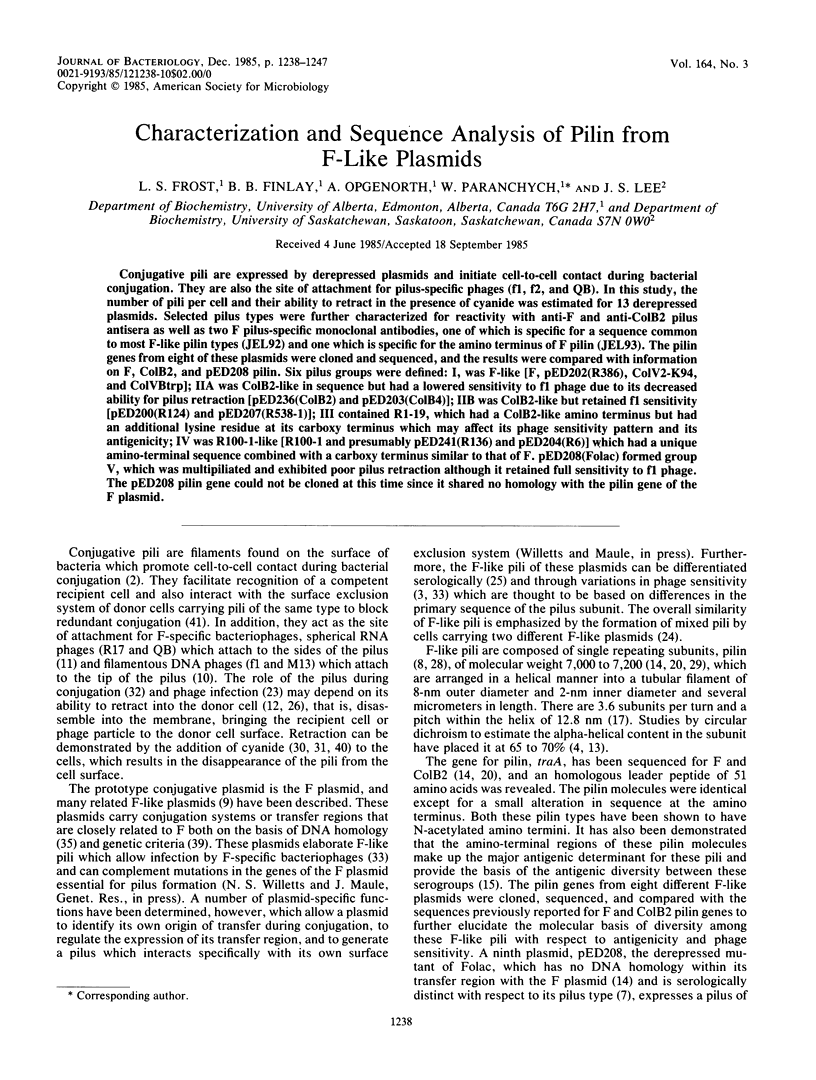
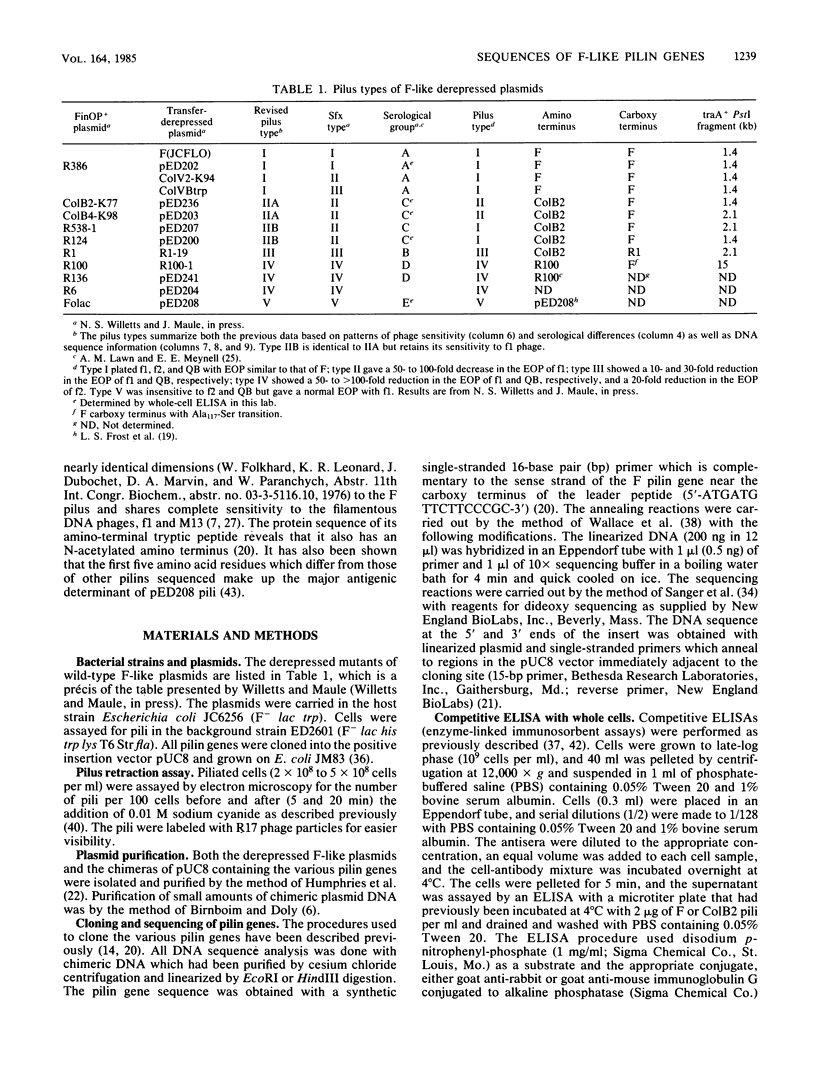
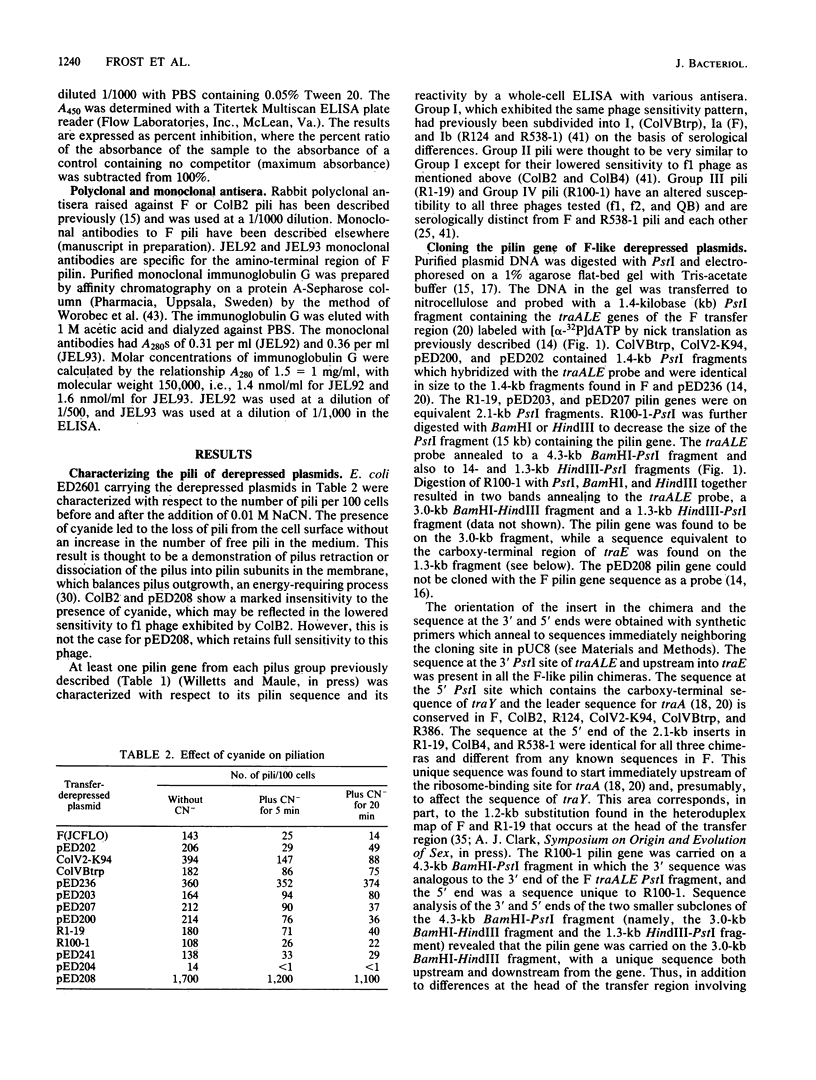
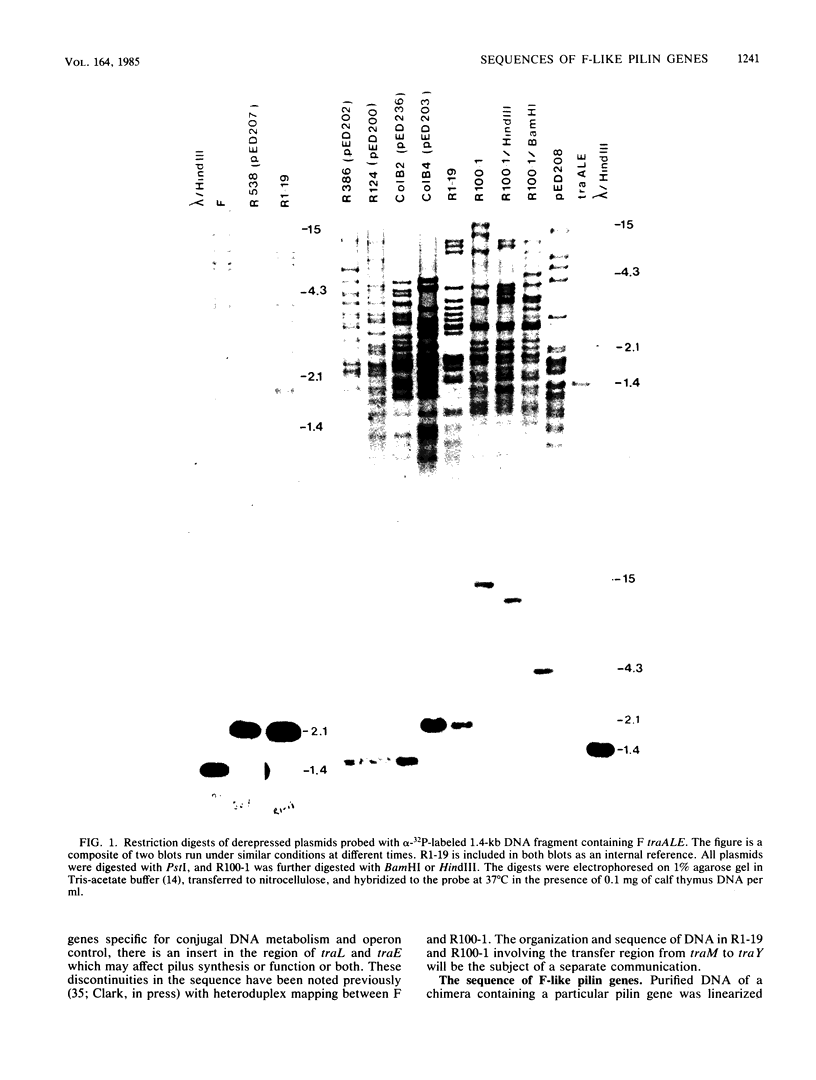
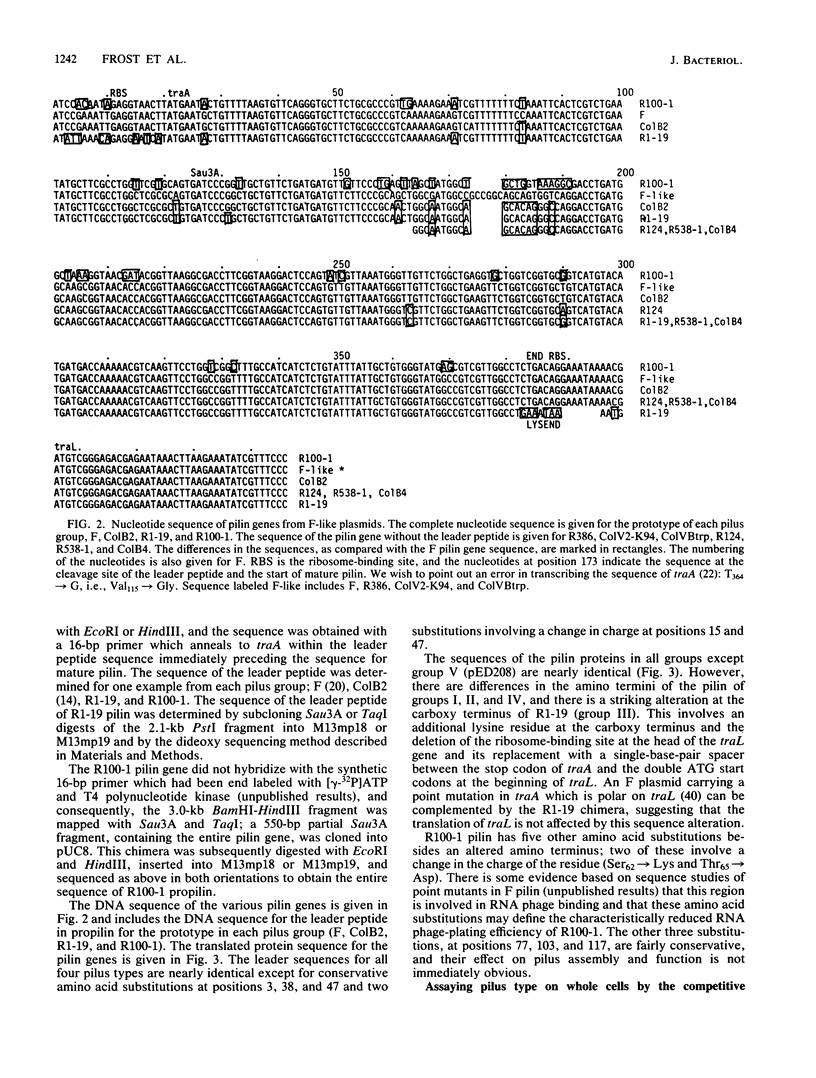

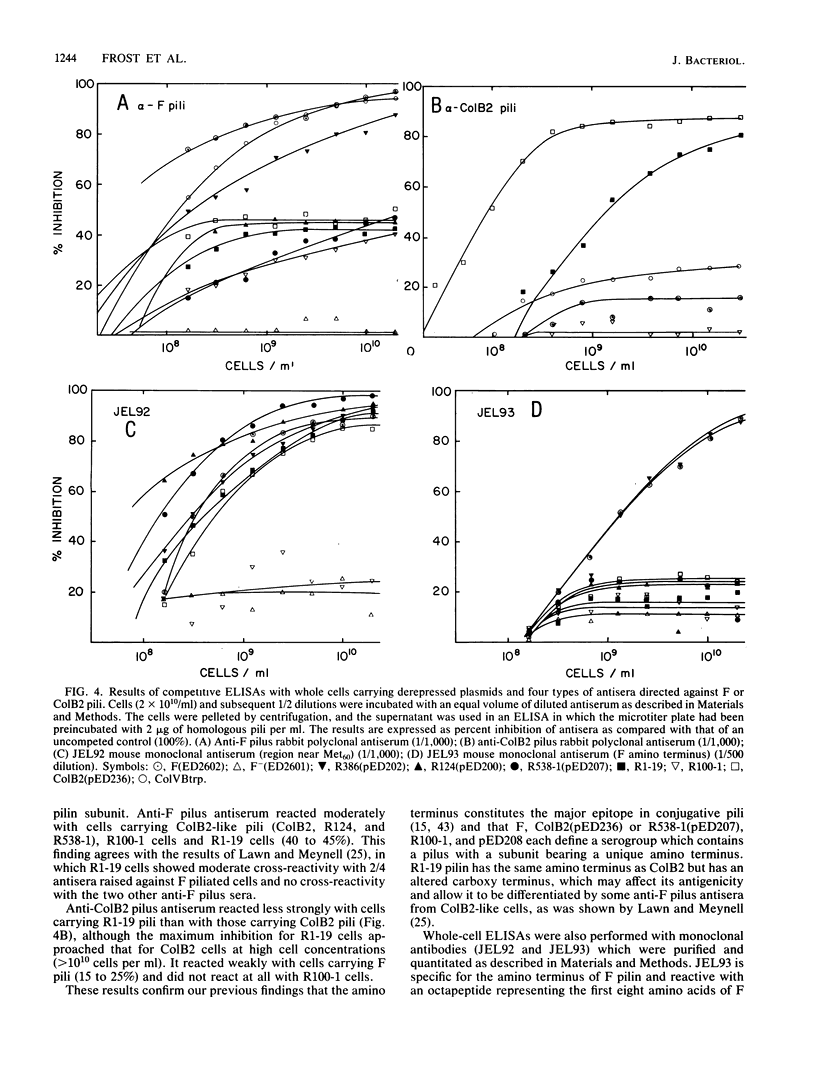
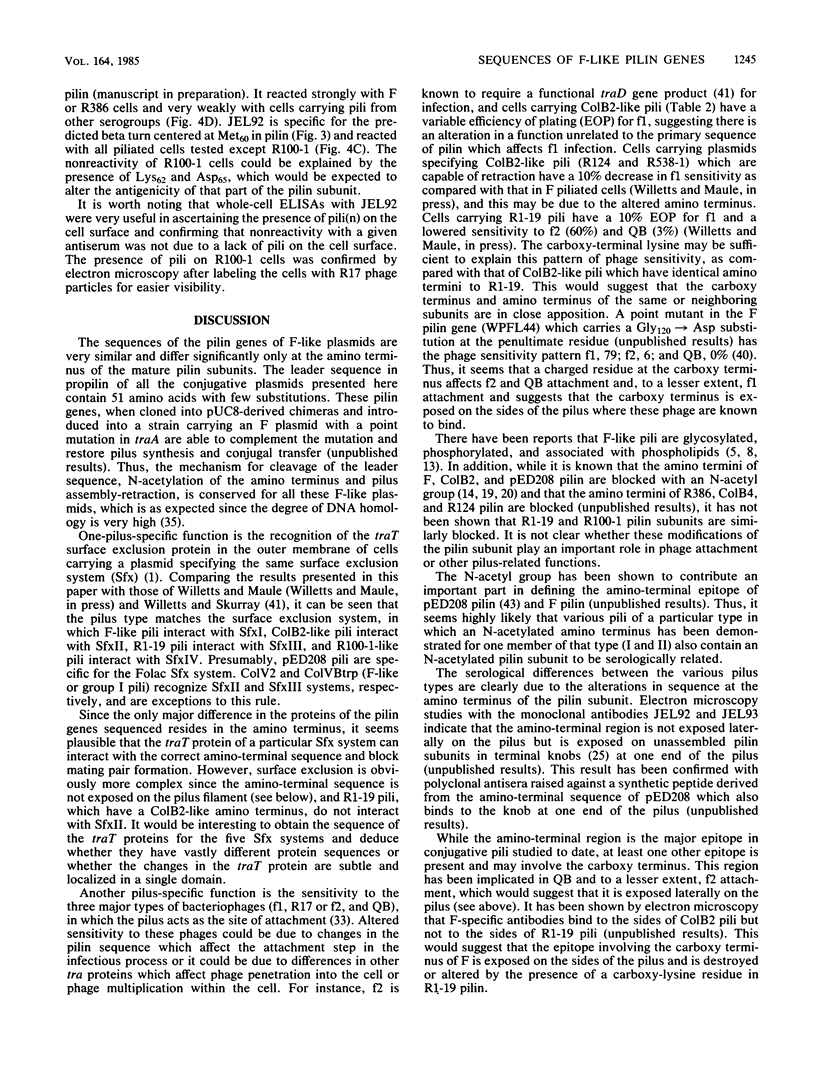
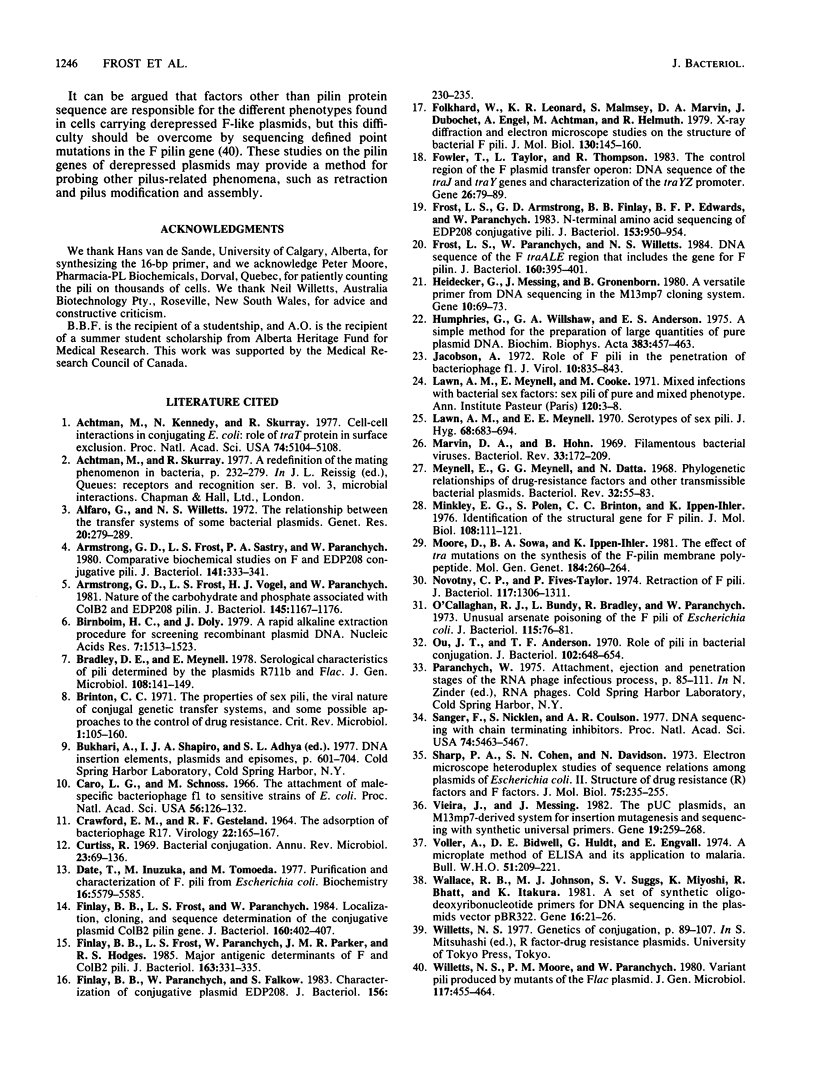
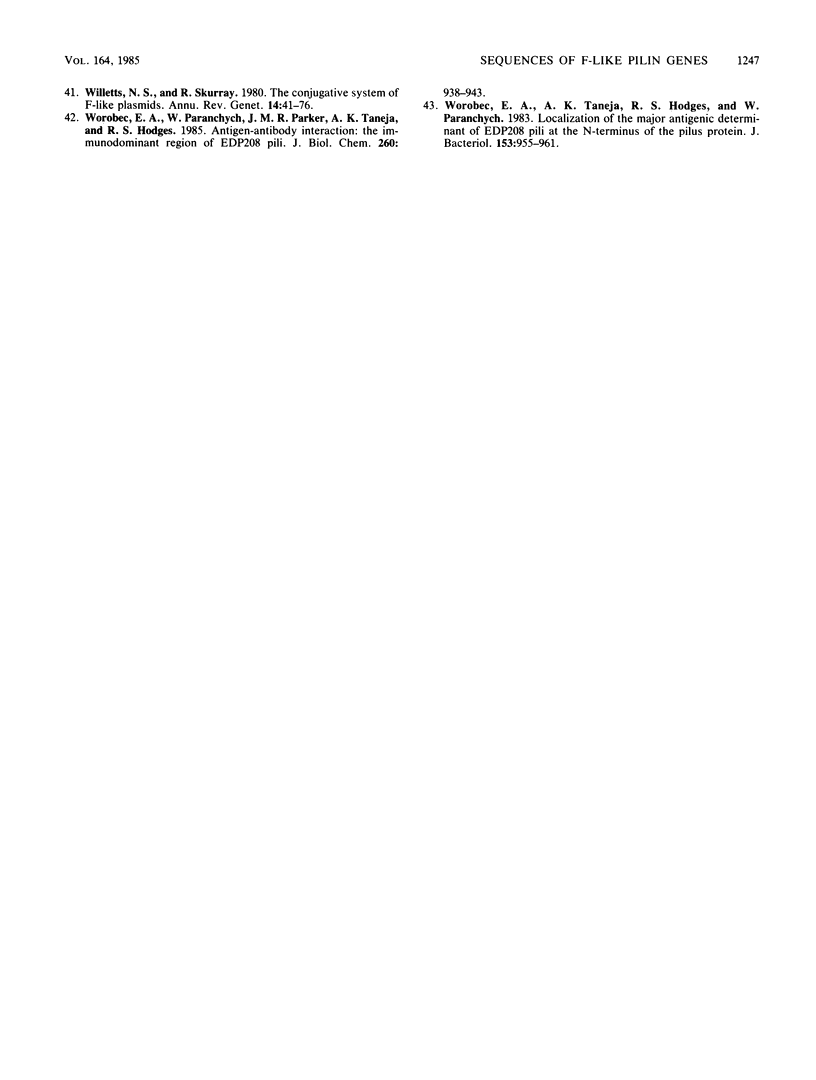
Images in this article
Selected References
These references are in PubMed. This may not be the complete list of references from this article.
- Achtman M., Kennedy N., Skurray R. Cell--cell interactions in conjugating Escherichia coli: role of traT protein in surface exclusion. Proc Natl Acad Sci U S A. 1977 Nov;74(11):5104–5108. doi: 10.1073/pnas.74.11.5104. [DOI] [PMC free article] [PubMed] [Google Scholar]
- Alfaro G., Willetts N. The relationship between the transfer systems of some bacterial plasmids. Genet Res. 1972 Dec;20(3):279–289. doi: 10.1017/s0016672300013811. [DOI] [PubMed] [Google Scholar]
- Armstrong G. D., Frost L. S., Sastry P. A., Paranchych W. Comparative biochemical studies on F and EDP208 conjugative pili. J Bacteriol. 1980 Jan;141(1):333–341. doi: 10.1128/jb.141.1.333-341.1980. [DOI] [PMC free article] [PubMed] [Google Scholar]
- Armstrong G. D., Frost L. S., Vogel H. J., Paranchych W. Nature of the carbohydrate and phosphate associated with ColB2 and EDP208 pilin. J Bacteriol. 1981 Mar;145(3):1167–1176. doi: 10.1128/jb.145.3.1167-1176.1981. [DOI] [PMC free article] [PubMed] [Google Scholar]
- Birnboim H. C., Doly J. A rapid alkaline extraction procedure for screening recombinant plasmid DNA. Nucleic Acids Res. 1979 Nov 24;7(6):1513–1523. doi: 10.1093/nar/7.6.1513. [DOI] [PMC free article] [PubMed] [Google Scholar]
- Bradley D. E., Meynell E. Serological characteristics of pili determined by the plasmids R711b and F0lac. J Gen Microbiol. 1978 Sep;108(1):141–149. doi: 10.1099/00221287-108-1-141. [DOI] [PubMed] [Google Scholar]
- Brinton C. C., Jr The properties of sex pili, the viral nature of "conjugal" genetic transfer systems, and some possible approaches to the control of bacterial drug resistance. CRC Crit Rev Microbiol. 1971 May;1(1):105–160. doi: 10.3109/10408417109104479. [DOI] [PubMed] [Google Scholar]
- Caro L. G., Schnös M. The attachment of the male-specific bacteriophage F1 to sensitive strains of Escherichia coli. Proc Natl Acad Sci U S A. 1966 Jul;56(1):126–132. doi: 10.1073/pnas.56.1.126. [DOI] [PMC free article] [PubMed] [Google Scholar]
- Curtiss R., 3rd Bacterial conjugation. Annu Rev Microbiol. 1969;23:69–136. doi: 10.1146/annurev.mi.23.100169.000441. [DOI] [PubMed] [Google Scholar]
- Date T., Inuzuka M., Tomoeda M. Purification and characterization of F pili from Escherichia coli. Biochemistry. 1977 Dec 13;16(25):5579–5585. doi: 10.1021/bi00644a030. [DOI] [PubMed] [Google Scholar]
- Finlay B. B., Frost L. S., Paranchych W. Localization, cloning, and sequence determination of the conjugative plasmid ColB2 pilin gene. J Bacteriol. 1984 Oct;160(1):402–407. doi: 10.1128/jb.160.1.402-407.1984. [DOI] [PMC free article] [PubMed] [Google Scholar]
- Finlay B. B., Frost L. S., Paranchych W., Parker J. M., Hodges R. S. Major antigenic determinants of F and ColB2 pili. J Bacteriol. 1985 Jul;163(1):331–335. doi: 10.1128/jb.163.1.331-335.1985. [DOI] [PMC free article] [PubMed] [Google Scholar]
- Finlay B. B., Paranchych W., Falkow S. Characterization of conjugative plasmid EDP208. J Bacteriol. 1983 Oct;156(1):230–235. doi: 10.1128/jb.156.1.230-235.1983. [DOI] [PMC free article] [PubMed] [Google Scholar]
- Folkhard W., Leonard K. R., Malsey S., Marvin D. A., Dubochet J., Engel A., Achtman M., Helmuth R. X-ray diffraction and electron microscope studies on the structure of bacterial F pili. J Mol Biol. 1979 May 15;130(2):145–160. doi: 10.1016/0022-2836(79)90423-6. [DOI] [PubMed] [Google Scholar]
- Fowler T., Taylor L., Thompson R. The control region of the F plasmid transfer operon: DNA sequence of the traJ and traY genes and characterisation of the traY leads to Z promoter. Gene. 1983 Dec;26(1):79–89. doi: 10.1016/0378-1119(83)90038-0. [DOI] [PubMed] [Google Scholar]
- Frost L. S., Armstrong G. D., Finlay B. B., Edwards B. F., Paranchych W. N-terminal amino acid sequencing of EDP208 conjugative pili. J Bacteriol. 1983 Feb;153(2):950–954. doi: 10.1128/jb.153.2.950-954.1983. [DOI] [PMC free article] [PubMed] [Google Scholar]
- Frost L. S., Paranchych W., Willetts N. S. DNA sequence of the F traALE region that includes the gene for F pilin. J Bacteriol. 1984 Oct;160(1):395–401. doi: 10.1128/jb.160.1.395-401.1984. [DOI] [PMC free article] [PubMed] [Google Scholar]
- Heidecker G., Messing J., Gronenborn B. A versatile primer for DNA sequencing in the M13mp2 cloning system. Gene. 1980 Jun;10(1):69–73. doi: 10.1016/0378-1119(80)90145-6. [DOI] [PubMed] [Google Scholar]
- Humphreys G. O., Willshaw G. A., Anderson E. S. A simple method for the preparation of large quantities of pure plasmid DNA. Biochim Biophys Acta. 1975 Apr 2;383(4):457–463. doi: 10.1016/0005-2787(75)90318-4. [DOI] [PubMed] [Google Scholar]
- Jacobson A. Role of F pili in the penetration of bacteriophage fl. J Virol. 1972 Oct;10(4):835–843. doi: 10.1128/jvi.10.4.835-843.1972. [DOI] [PMC free article] [PubMed] [Google Scholar]
- Lawn A. M., Meynell E., Cooke M. Mixed infections with bacterial sex factors: sex pili of pure and mixed phenotype. Ann Inst Pasteur (Paris) 1971 Jan;120(1):3–8. [PubMed] [Google Scholar]
- Lawn A. M., Meynell E. Serotypes of sex pili. J Hyg (Lond) 1970 Dec;68(4):683–694. doi: 10.1017/s0022172400042625. [DOI] [PMC free article] [PubMed] [Google Scholar]
- Marvin D. A., Hohn B. Filamentous bacterial viruses. Bacteriol Rev. 1969 Jun;33(2):172–209. doi: 10.1128/br.33.2.172-209.1969. [DOI] [PMC free article] [PubMed] [Google Scholar]
- Meynell E., Meynell G. G., Datta N. Phylogenetic relationships of drug-resistance factors and other transmissible bacterial plasmids. Bacteriol Rev. 1968 Mar;32(1):55–83. doi: 10.1128/br.32.1.55-83.1968. [DOI] [PMC free article] [PubMed] [Google Scholar]
- Minkley E. G., Jr, Polen S., Brinton C. C., Jr, Ippen-Ihler K. Identification of the structural gene for F-pilin. J Mol Biol. 1976 Nov;108(1):111–121. doi: 10.1016/s0022-2836(76)80098-8. [DOI] [PubMed] [Google Scholar]
- Moore D., Sowa B. A., Ippen-Ihler K. The effect of tra mutations on the synthesis of the F-pilin membrane polypeptide. Mol Gen Genet. 1981;184(2):260–264. doi: 10.1007/BF00272914. [DOI] [PubMed] [Google Scholar]
- Novotny C. P., Fives-Taylor P. Retraction of F pili. J Bacteriol. 1974 Mar;117(3):1306–1311. doi: 10.1128/jb.117.3.1306-1311.1974. [DOI] [PMC free article] [PubMed] [Google Scholar]
- O'Callaghan R. J., Bundy L., Bradley R., Paranchych W. Unusual arsenate poisoning of the F pili of Escherichia coli. J Bacteriol. 1973 Jul;115(1):76–81. doi: 10.1128/jb.115.1.76-81.1973. [DOI] [PMC free article] [PubMed] [Google Scholar]
- Ou J. T., Anderson T. F. Role of pili in bacterial conjugation. J Bacteriol. 1970 Jun;102(3):648–654. doi: 10.1128/jb.102.3.648-654.1970. [DOI] [PMC free article] [PubMed] [Google Scholar]
- Sanger F., Nicklen S., Coulson A. R. DNA sequencing with chain-terminating inhibitors. Proc Natl Acad Sci U S A. 1977 Dec;74(12):5463–5467. doi: 10.1073/pnas.74.12.5463. [DOI] [PMC free article] [PubMed] [Google Scholar]
- Sharp P. A., Cohen S. N., Davidson N. Electron microscope heteroduplex studies of sequence relations among plasmids of Escherichia coli. II. Structure of drug resistance (R) factors and F factors. J Mol Biol. 1973 Apr 5;75(2):235–255. doi: 10.1016/0022-2836(73)90018-1. [DOI] [PubMed] [Google Scholar]
- Vieira J., Messing J. The pUC plasmids, an M13mp7-derived system for insertion mutagenesis and sequencing with synthetic universal primers. Gene. 1982 Oct;19(3):259–268. doi: 10.1016/0378-1119(82)90015-4. [DOI] [PubMed] [Google Scholar]
- Voller A., Bidwell D., Huldt G., Engvall E. A microplate method of enzyme-linked immunosorbent assay and its application to malaria. Bull World Health Organ. 1974;51(2):209–211. [PMC free article] [PubMed] [Google Scholar]
- Wallace R. B., Johnson M. J., Suggs S. V., Miyoshi K., Bhatt R., Itakura K. A set of synthetic oligodeoxyribonucleotide primers for DNA sequencing in the plasmid vector pBR322. Gene. 1981 Dec;16(1-3):21–26. doi: 10.1016/0378-1119(81)90057-3. [DOI] [PubMed] [Google Scholar]
- Willetts N. S., Moore P. M., Paranchych W. Variant pili produced by mutants of the Flac plasmid. J Gen Microbiol. 1980 Apr;117(2):455–464. doi: 10.1099/00221287-117-2-455. [DOI] [PubMed] [Google Scholar]
- Willetts N., Skurray R. The conjugation system of F-like plasmids. Annu Rev Genet. 1980;14:41–76. doi: 10.1146/annurev.ge.14.120180.000353. [DOI] [PubMed] [Google Scholar]
- Worobec E. A., Paranchych W., Parker J. M., Taneja A. K., Hodges R. S. Antigen-antibody interaction. The immunodominant region of EDP208 pili. J Biol Chem. 1985 Jan 25;260(2):938–943. [PubMed] [Google Scholar]
- Worobec E. A., Taneja A. K., Hodges R. S., Paranchych W. Localization of the major antigenic determinant of EDP208 pili at the N-terminus of the pilus protein. J Bacteriol. 1983 Feb;153(2):955–961. doi: 10.1128/jb.153.2.955-961.1983. [DOI] [PMC free article] [PubMed] [Google Scholar]



